Upper Red Lake: Paradise on ice
Northern Minnesota’s premier ice-fishing destination
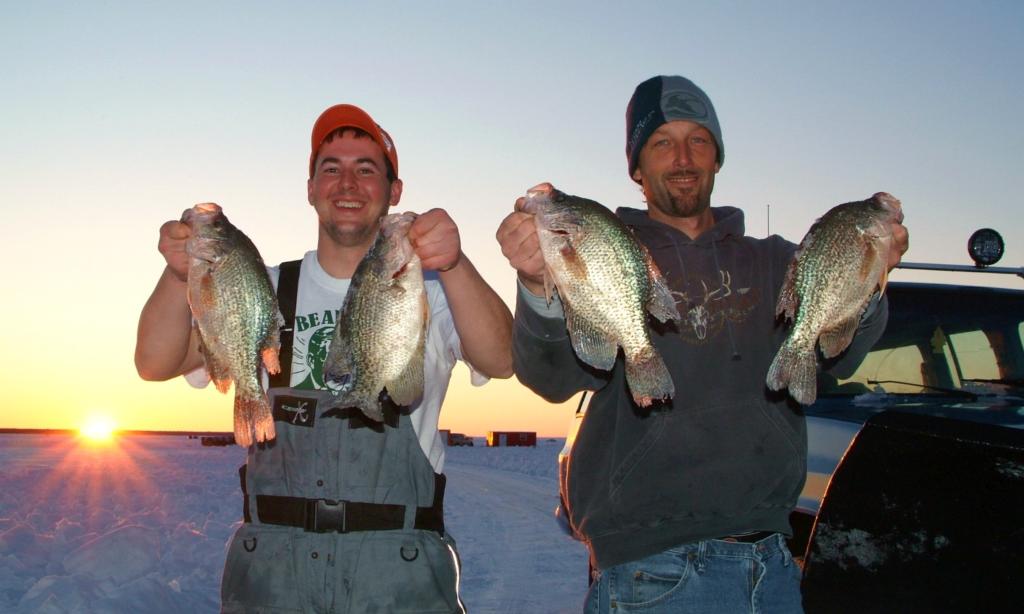
Fifteen years ago it was considered a dead sea. Although hard to believe at over 250,000 acres, Red Lake was totally depleted by commercial netting. In 1995 an amazing class of crappies established themselves in the lake. For the next decade, the crappies exploded and the fishing was phenomenal, with anglers catching dozens in the 12- to 16-inch range. That crappie class is dwindling, but Red Lake has recently undergone another transformation – this time becoming the No. 1 walleye-fishing destination in the Midwest.
Located an hour north of Bemidji in northern Minnesota, Red Lake is the largest inland lake in the state. The fishery is actually two massive, connected lakes. The Red Lake Native American Band controls all 152,000 acres of Lower Red Lake and 60,000 acres of Upper Red Lake – leaving roughly 48,000 acres to the state of Minnesota. The reservation waters are off-limits to anyone not enrolled in the band, but the 48,000 acres in the eastern corner can be fished by anyone.
The sudden increase in crappies that began in the mid-’90s was the result of a walleye bust caused by 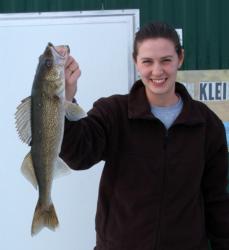 years of overharvest. In other words, the crappies flourished by taking advantage of vacant biological habitat. Although the crappie boom was a blast, Red Lake is more naturally suited for walleyes. In 1998, the Red Lake Native American Band prohibited all netting, and the state reduced the walleye bag limit to two fish in 1998 and then to zero in 1999.
years of overharvest. In other words, the crappies flourished by taking advantage of vacant biological habitat. Although the crappie boom was a blast, Red Lake is more naturally suited for walleyes. In 1998, the Red Lake Native American Band prohibited all netting, and the state reduced the walleye bag limit to two fish in 1998 and then to zero in 1999.
An agreement between the band and the state in 1999 called for stocking roughly 40 million walleye fry up to five times during the next decade. Those stocking efforts are now complete, and the population is healthy and steadily growing. The current limit for walleyes is three fish per person, only one of which can be longer than 26 inches. In addition, all walleyes 17 to 26 inches in length must be immediately returned to the water.
Chad Benson, an accomplished tournament fisherman, lives in the area and has been guiding since 1991. Each summer he fishes the Minnesota Division of the Walmart FLW Walleye League. Within the past four years, Benson has five top-10 tournament finishes to his name – including a victory on Cass Lake in June 2005. In the summer, most of his guide trips take place on the Cass chain or on Lake Bemidji. While Benson loves Cass and considers it his home water, he heads north to Red each winter. Over the years, he’s seen the lake’s transformation firsthand.
“When the crappies first started booming, we’d come out right before sunset in portables,” Benson said of ice-fishing on Red Lake. “The fishing was just wild – you’d look out at the lake and just see lights for miles. You can still get a few crappies, but the walleyes have really taken over, and that’s a good thing. Two years ago, when the walleye season first opened, we camped our (ice) houses near the reservation line and caught 50 to 100 walleyes a day for two weeks straight. It was just a blast.”
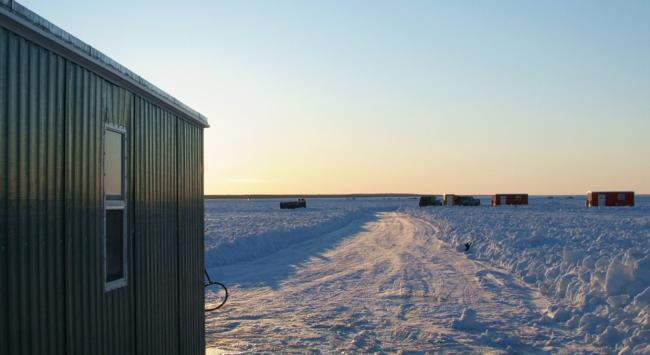 Benson is widely regarded as the authority on Red Lake fishing. Mention his name anywhere from Bemidji to Waskish and the compliments start flying. This reputation is no fluke – it was built over the years with tireless effort. To that end, it’s no surprise that each of his seven rental houses is fully booked on just about every weekend. Each house is furnished with rattle reels, direct-vent heaters, lights, a two-burner cook stove, bunk beds, a table and chairs, and even a carbon-monoxide detector. The houses have eight holes, which are drilled upon arrival. There are approximately 30 businesses in the area that offer a similar service, but Benson provides a personal, professional experience. For example, Benson checks on his clients three to four times per day in case a house needs to be moved. When he isn’t talking with clients or moving houses, he’s likely plowing roads on the ice, another thankless task that goes with the job. By next winter, he hopes to expand to 10 fish houses.
Benson is widely regarded as the authority on Red Lake fishing. Mention his name anywhere from Bemidji to Waskish and the compliments start flying. This reputation is no fluke – it was built over the years with tireless effort. To that end, it’s no surprise that each of his seven rental houses is fully booked on just about every weekend. Each house is furnished with rattle reels, direct-vent heaters, lights, a two-burner cook stove, bunk beds, a table and chairs, and even a carbon-monoxide detector. The houses have eight holes, which are drilled upon arrival. There are approximately 30 businesses in the area that offer a similar service, but Benson provides a personal, professional experience. For example, Benson checks on his clients three to four times per day in case a house needs to be moved. When he isn’t talking with clients or moving houses, he’s likely plowing roads on the ice, another thankless task that goes with the job. By next winter, he hopes to expand to 10 fish houses.
“This has been my best year ever,” he said. “I feel real fortunate to say that, because I know a lot of people in the fishing industry are struggling. I work hard and take a lot of pride in my reputation. In the summer, 80 percent of my business is repeat clients or referrals. I’m in the business of making people happy, and usually that means putting them on fish.”
Benson has never advertised – his good name has been built solely on word of mouth. He has become so busy that he oftentimes steers potential clients to Ryan Klein, a friend and fellow tournament angler. 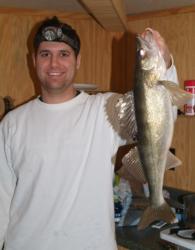 Klein finished 22nd at the Cass Lake Walleye Tour event and is a protege of sorts to Benson.
Klein finished 22nd at the Cass Lake Walleye Tour event and is a protege of sorts to Benson.
“Ryan is a great fisherman in his own right – probably better than me. Hopefully they start calling him now because my phone rings too much as it is.”
Benson said the most difficult part of his job is managing client expectations.
“Some guys are happy catching six walleyes in a day. Other guys are upset when they only catch 25 walleyes in a day. This lake will spoil a guy.”
Upper Red is unique in that, unlike most northern Minnesota glacial lakes, it is shallow and has very little structure. Because it is shallow, it freezes up faster and better than other area lakes. For example, the best walleye spots on Leech Lake this winter were largely impassable. On nearby Cass and Winnibigoshish, walleyes hang tight to breaks, especially in the summer. On Red, the fish continually roam – making patience slightly more significant than location. Benson takes a unique approach to patterning these nomadic walleyes.
“I almost do the opposite. Rather than looking below the ice, I look above. A lot of my best spots are found while I’m plowing. If I come across an area with jagged, hard ice chunks, I might try it. If there is pure snow everywhere else, the water below the ice chunks will probably hold fish.”
Benson also said the fish sometimes follow pressure lines. These are easy to identify by the ridges and cracks on the surface of the ice. If all else fails, he will simply move his houses to a pristine area that hasn’t received much fishing pressure.
“There might not be as many fish in the area overall, but because they haven’t been hammered, I know they will bite better.”
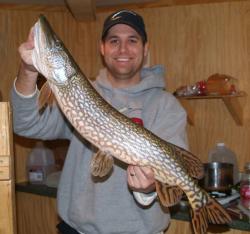 In terms of quantity, the walleye fishing is so good at times it becomes tedious. That sounds hard to believe, but it is true. A poor day of walleye fishing on Red is approximately six per person. The average size is between 15 and 20 inches. If there is a downside, it is that true monsters are hard to come by. Walleyes longer than 24 inches are rare, but it can happen. As a bonus, monster-sized pike are increasing in numbers. Just when an angler thinks he has hooked into a 28-inch walleye, the pike will peel line and readily identify itself by the sound of screaming drag. Northerns up to 40 inches are common, but they are difficult to land in 8-inch holes.
In terms of quantity, the walleye fishing is so good at times it becomes tedious. That sounds hard to believe, but it is true. A poor day of walleye fishing on Red is approximately six per person. The average size is between 15 and 20 inches. If there is a downside, it is that true monsters are hard to come by. Walleyes longer than 24 inches are rare, but it can happen. As a bonus, monster-sized pike are increasing in numbers. Just when an angler thinks he has hooked into a 28-inch walleye, the pike will peel line and readily identify itself by the sound of screaming drag. Northerns up to 40 inches are common, but they are difficult to land in 8-inch holes.
The walleye bite is best in the early season. From first ice through the holidays, incredible trips are common. By mid-February, the walleye bite slows considerably, but the crappies begin to make an occasional appearance.
As far as presentations, Red Lake walleyes prefer the tried and true jig-and-minnow combination. Shiners, rainbows, creek chubs and fatheads are the most popular minnows. A good strategy is to jig for active fish with one line and employ a subtle dead-stick with the second. In Minnesota, two lines per person are allowed in the winter, but only one line per person is allowed in the summer. The second line is extremely advantageous on Red as most of the fish come on the dead-stick.
“A lot of people like to call in the fish with a big rattling, jigging spoon,” said Benson. “Once you’ve called them in, they will usually bite the dead-stick.”
As for specifics, white glow hooks work well on rattle reels and slip-bobbers, as do red hooks. Glass jigs, pink and white glow jigs, and jigging Shad Raps are also effective. In a way, Red Lake offers a throwback experience where fancy electronics and innovative lures aren’t necessary to catch fish.
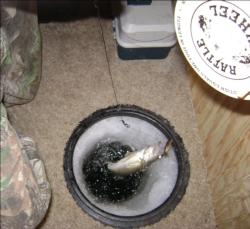
“Sometimes a plain No. 4 hook and a healthy minnow is the best way to go.”
Benson believes the fishery has a bright future, especially for walleyes. After all, much of his livelihood depends on it.
“The slot limit is doing its job. The crappies are slowly going away, but that was a rare phenomenon. The walleye fishing should be good as long as they protect those 20- to 26-inch females. Long term, this lake is here to stay.”
For more information on Upper Red Lake fishing, visit the Upper Red Lake Area Association at upperredlakeassn.com. For more information on Chad Benson’s guiding service and fish-house rentals, visit www.chadsguideservice.com or call (218) 556-0823. Benson can also be reached via e-mail at [email protected]. Ryan Klein can be reached at (218) 766-8605 or at www.ryansguideservice.com.